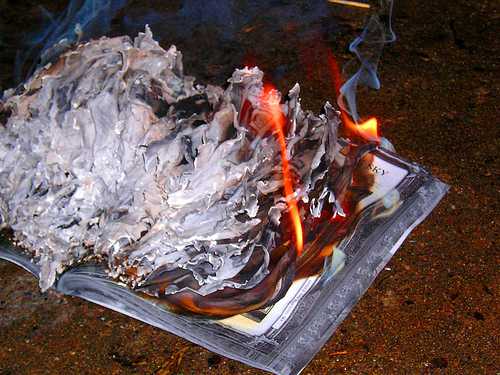FWP:
For background see S. R. Faruqi's choices. This verse is NOT one of his choices; mostly for completeness, I have added it myself. For more on Ghalib's unpublished verses, see the discussion in {4,8x}.
We're apparently meant to think of the way a piece of paper can be struck by flying embers, so that roundish burning holes open up wherever the embers land; the holes themselves have red, smoldering edges, and constantly widen themselves until the whole paper either crumples into ash or bursts into flame.
In the same way, each glowing, red-bordered, expanding wound of desire seems to be 'hot' or enthusiastic with a fervent eagerness to spread its influence around: it restlessly seeks to create or 'invent' new, 'fresh' wounds of desire.
The speaker is like this kind of 'burnt paper' full of smoldering holes-- thus he's also like a 'lamp-display', offering many individual points of fiery efflorescence. For more on chiraa;Gaa;N , see {5,5}. But of course the grammar gives us three entities-- the 'lamp-display', the 'burnt paper', and the 'wound'-- and forces us, as so often, to figure out for ourselves how exactly to connect them. What is a metaphor for what? Are we to envision three separate situations, or two, or merely one (with metaphorical elaboration)? The choice is ours to make.
To say that 'the wound was eager/hot in the attempt to invent
a fresh wound' also feels like an insight into the nature of lust. The constant
pursuit of novelty, the effort to invent and 'discover' ever-newer, ever more
irresistible objects of desire, is surely what
lies at the heart of lust. What 'heats up' the wound of lust is not really
the thought of the beloved, but the desire to invent more such wounds. Such a desire-fire might be as suddenly destructive as
the burning of a piece of paper-- but also as brilliantly beautiful
as a light-show.

Zamin:
The meaning of chiraa;Gaan , the author of the [dictionary] ;Giyaa;s ul-lu;Gaat gives as 'a species of punishment in which holes were made here and there in the criminal's head, and a wick was placed in each and lighted'. It's possible that in the time of barbarism and ignorance such a punishment might have been used; this is a matter of historical research. In common usage, a chiraa;Gaan means for many lamps to be gathered together, as is done for Divali and Shab-e Barat and other celebrations. In this verse both meanings can apply.
He says, 'From head to foot I am becoming a lamp-display of the wounds of desire/lust, and my condition is like that of burnt paper in which one spark dies while another one arises'. (Every single wound is attempting to create a new wound.) First the poet has used for desire the metaphor of a wound, then he has supposed in the wound a glitter/gleam; thus for the way that after one longing is deferred, another one is created, he has given the simile of burnt paper-- in which after one spark dies, another one is created.
== Zamin, p. 52